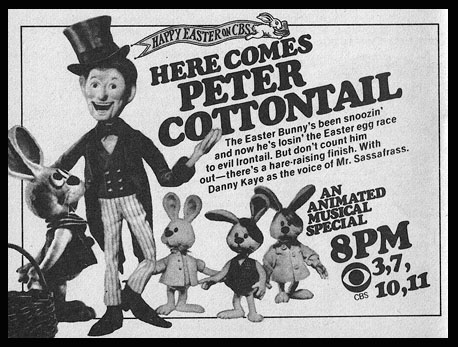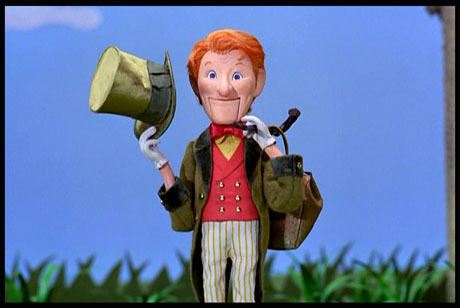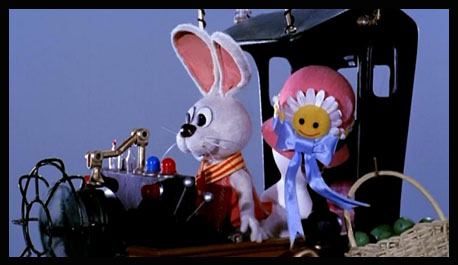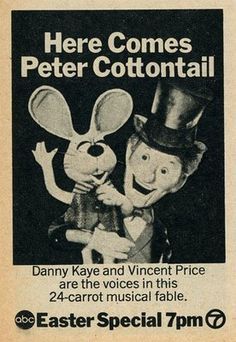
It’s only natural that the Rankin/Bass Studio produced Here Comes Peter Cottontail. After all, before the special airing in 1971, the Studio had made quite the name for itself, translating popular Christmas songs, such as Rudolph the Red-Nosed Reindeer, Frosty the Snowman, and Santa Claus is Comin’ to Town into equally popular TV specials. It only made perfect sense for the Studio to do the same for Easter’s most famous song (although other than this and “Easter Parade,” there’s not much to choose from).

Like those specials, the artists at Rankin/Bass turned a song into an “origin story” of sorts. Here Comes Peter Cottontail now celebrates its 50th anniversary this Easter Season. While it may not have had the repeatability stamina that Rankin/Bass’ Christmas specials like Rudolph and Frosty have had through the years, Peter Cottontail has its own devotees and has emerged as one of the Studios beloved classics.
The song upon which the special is based was released in 1949. Written by Steve Nelson and Jack Rollins, the songwriting Team that would bring us “Frosty the Snowman,” they approached the Singing Cowboy Gene Autry to record “Here comes Peter Cottontail.” Autry had a hit with “Here Comes Santa Claus,” and there was the thought that success could be replicated with an Easter song.
“Here Comes Peter Cottontail” actually cracked Billboard’s Top 10 songs, so it made perfect sense that when Rankin/Bass left their holiday “safe zone” of Christmas to create an Easter special that they would base their first for this holiday on this popular song.
The other inspiration for the special was the 1957 children’s book, The Easter Bunny That Overslept by Priscilla and Otto Friedrich.

With this, the Studio used a similar formula that was in place just a year before with their successful and unique Santa Claus is Comin’ to Town: a song-and-dance narrator relays an “origin story” of a holiday icon. With Santa Claus, it was Fred Astaire, for Peter Cottontail, it’s Danny Kaye, who provides the caricature and voice for Seymour J. Sassafrass.
Sassafrass is a traveling salesman who tells us Peter Cottontail’s story (Peter is none other than the warm and soothing voice of Casey Kasem). Peter lives in Easter Valley with all of the other bunnies. It’s here that all of the Easter candy, bonnets, and colored eggs are made.
The current Easter Bunny, Colonel Wellington (also voiced by Kaye), is about to retire and names Peter as his replacement. Enter the villain, January Q. Irontail, a black and grey rabbit with an iron tail (a prosthetic after a skateboarding child ran over his cotton one). He also has the voice of horror movie legend Vincent Price.
Irontail proposes a contest between himself and Peter: whoever can deliver the most Easter eggs will become Easter Bunny. Irontail cheats by allowing Peter to oversleep. The villainous rabbit delivers all the eggs himself, and becomes the Easter bunny.
Here, in some scenes that are seem to foreshadow Tim Burton’s The Nightmare Before Christmas, Irontail decides to make chocolate spiders instead of bunnies and galoshes instead of bonnets.
Distraught, Peter leaves April Valley but is provided with some hope. Sassafrass gives him his time traveling “Yestermorrowbile,” piloted by Antione the caterpillar (Kaye again); this allows Peter to travel to other holidays, attempt to deliver eggs there, and potentially “win back” Easter.

From here, Peter travels to Mother’s Day, July Fourth, Halloween, Thanksgiving, Christmas, Valentine’s Day, and St. Patrick’s Day, attempting to deliver eggs to all on these holidays. Is he successful? Does he become the Easter Bunny? If it’s been fifty years since you’ve seen Here Comes Peter Cottontail, there will be no spoilers here.
This time-travel plot device makes Here Comes Peter Cottontail unique in that it not only becomes an Easter special, but it also becomes every holiday’s special. What’s fun about this is that we get to see how Rankin/Bass, a studio so synonymous with holidays, interprets and represents holidays outside of Christmas and Easter. Their version of Halloween has shades of their 1967 feature Mad Monster Party, and the Valentine’s Day skating party is oh-so pleasant.

An original ad from TV Guide
Kaye would go on to partner with the Rankin/Bass studio for another special, The Emperor’s New Clothes, which was broadcast on ABC in 1972 and was to be a part of a series of specials entitled The Enchanted World of Danny Kaye. Unfortunately, there were no other specials produced.
In addition to Kaye, the other casting coup in Peter Cottontail was Vincent Price as Irontail. He emerges as one of Rankin/Bass’ more memorable villains. The actor’s unique voice, so immediately associated with horror, coupled with the character’s darker look and tone, was a nice off-set to the Springtime setting.
And Spring indeed has sprung in Here Comes Peter Cottontail. Thanks to Rankin/Bass’ stop-motion animation technique, dubbed “Animagic,” the artists genuinely take advantage of all that is bright and colorful about the holiday and the season.
With its bunnies carving chocolate rabbits like great sculptors, April Valley truly captures a childlike, fantastic perspective of Easter. And the colorful backdrops of scenes like that in which Peter meets Seymour Sassafrass is filled with the kind of beautiful, creative environment that we have come to love about Rankin/Bass specials.
While not aired regularly through the years as many of Rankin/Bass Christmas specials have been, Here Comes Peter Cottontail has emerged as a nostalgic favorite among many when it comes to annual Easter viewings. Another, more recent Easter Bunny story also celebrates an anniversary and will be part of next week’s column.
In the meantime, “Hippity Hoppity, Easter’s on its way.”
- An Eye for A Classic: The 60th Anniversary of “Mr. Magoo’s Christmas Carol” - December 22, 2022
- A Very Merry Mickey: The 70th Anniversary of “Pluto’s Christmas Tree” - December 19, 2022
- A Fine French Feline Film: The 60th Anniversary of “Gay Pur-ee” - December 12, 2022


 March 28th, 2021
March 28th, 2021  Michael Lyons
Michael Lyons  Posted in
Posted in  Tags:
Tags: 






